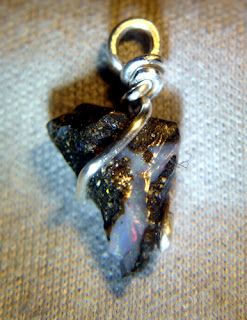 I now have little display cases for them!
I now have little display cases for them!(I wanted to put the little "Australian Opal" stickers on the cases, but they would've obscured 75% of the lid...)
Actually, this entry was composed as rant, but I might as well tell you about some of the processes behind the wire-wrapped opals I've been posting.
I've been using 22 gauge, round sterling wire in half-hard temper. I do have some full-soft sterling in 0.6mm, marginally thinner than 22ga, and I will try some 0.5mm half-hard next.
I call these things "wire-wrapped" though there's not much wrapping--I'm mostly shaping the wires into a frame/cage for the stone, and that's done with pliers and hands.
Some of the chips I have are poorly finished, so I've acquired some 6000 and 8000 grit abrasives, and they've brought some chips to an acceptable polish. There are several stones, though, without the stereotypical opal "fire," though they are still beautifully iridescent. I think they're still worth wrapping, so I'll being doing that soon enough.
Most of the chips I haven't wrapped yet were just in need of a bit of shine, but I want to modify the shapes for
a few.
And here's the rant: there's one stone where I wanted to remove the burr that the cutter neglected to finish removing. The problem is that this stone is barely 3mm wide and 12mm long, so it's difficult to manipulate the little bugger. In any case, I managed to gash my finger pretty deeply while filing this thing. I dropped the stone and file and scooted to the sink to wash off the dirt. I've generally stopped using band-aids, so I had to superglue the cut (actually, I had to Zap-a-Gap the cut), use some tissue over the zapped gap, and bind the whole contrivance with sports tape. Now I'm having difficulty typing, much less manipulating jewelry... *Whines* Astoundingly, the cut didn't bleed at all, so I'm pretty thankful for that.
But I managed to misplace/drop/lose the stone during the chaos that was trying to get the cut sealed. It took me about an hour of rooting through my desk and environs before I found the damn thing. (It's conveniently the same color as my carpeting.) Meh. Frustrating thing is, I doubt this stone is going to look all that great, but with the amount of trouble I've gone through for this one (additional polish, burr filing, gash) it'd better be friggin' stunning.

















